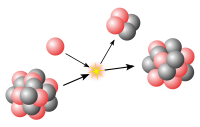
Back انبعاث البوزيترون Arabic Emisión de positrones AST Emissió de positrons Catalan Přeměna beta plus Czech Beta-Plus-Zerfall German Emisión de positrones Spanish نشر پوزیترون Persian Positroniemissio Finnish Émission de positon French Emisi positron ID
| Nuclear physics |
|---|
 |
Positron emission, beta plus decay, or β+ decay is a subtype of radioactive decay called beta decay, in which a proton inside a radionuclide nucleus is converted into a neutron while releasing a positron and an electron neutrino (νe).[1] Positron emission is mediated by the weak force. The positron is a type of beta particle (β+), the other beta particle being the electron (β−) emitted from the β− decay of a nucleus.
An example of positron emission (β+ decay) is shown with magnesium-23 decaying into sodium-23:
- 23
12Mg
→ 23
11Na
+
e+
+
ν
e
Because positron emission decreases proton number relative to neutron number, positron decay happens typically in large "proton-rich" radionuclides. Positron decay results in nuclear transmutation, changing an atom of one chemical element into an atom of an element with an atomic number that is less by one unit.
Positron emission occurs extremely rarely in nature on Earth. Known instances include cosmic ray interactions and the decay of certain isotopes, such as potassium-40. This rare form of potassium makes up only 0.012% of the element on Earth and has a 1 in 100,000 chance of decaying via positron emission.
Positron emission should not be confused with electron emission or beta minus decay (β− decay), which occurs when a neutron turns into a proton and the nucleus emits an electron and an antineutrino.
Positron emission is different from proton decay, the hypothetical decay of protons, not necessarily those bound with neutrons, not necessarily through the emission of a positron, and not as part of nuclear physics, but rather of particle physics.
- ^ "Nuclear Chemistry". The University of North Carolina at Chapel Hill. Retrieved 2012-06-14.
© MMXXIII Rich X Search. We shall prevail. All rights reserved. Rich X Search